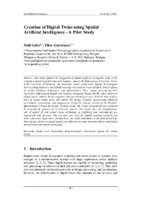Creation of Digital Twins using Spatial Artificial Intelligence - A Pilot Study

View/
Metadata
Show full item record
URI
Collections
Abstract
This study explores the integration of spatial artificial intelligence (SAI) in the
creation a digital twin of a university campus - namely the Zalaegerszeg University Centre
of the University of Pannonia - for immersive virtual reality tours. Spatial AI techniques
such as photogrammetry and LiDAR scanning were used to create detailed virtual replicas
of campus buildings, landscapes, and infrastructure. These virtual environments also
represent a shift towards Digital and Cognitive Corporate Reality (DCR), where AI-driven
digital spaces enhance human cognitive and operational processes. With the help of these
tours in virtual reality, users can explore the campus remotely, experiencing enhanced
accessibility, interactivity, and engagement. Using the 4-factor version of the Presence
Questionnaire 3.0 and the System Usability Scale, the virtual environment was evaluated
by assessing the opinions of 18 university students. Our results show the transformative
role of spatial AI and virtual reality technology in redefining how environments are
experienced and accessed. This can open new ways for spatial cognition research and
other, immersive experiences. Furthermore, our study contributes to the field of DCR by
showing how AI-driven spatial models can influence learning, decision making, and digital
interaction in educational institutions.
- Title
- Creation of Digital Twins using Spatial Artificial Intelligence - A Pilot Study
- Author
- Szűcs, Judit
- Guzsvinecz, Tibor
- xmlui.dri2xhtml.METS-1.0.item-date-issued
- 2025
- xmlui.dri2xhtml.METS-1.0.item-rights-access
- Open access
- xmlui.dri2xhtml.METS-1.0.item-identifier-issn
- 1785-8860
- xmlui.dri2xhtml.METS-1.0.item-language
- en
- xmlui.dri2xhtml.METS-1.0.item-format-page
- 14 p.
- xmlui.dri2xhtml.METS-1.0.item-subject-oszkar
- digital twin, digitization, human-computer interaction, spatial AI, virtual reality
- xmlui.dri2xhtml.METS-1.0.item-description-version
- Kiadói változat
- xmlui.dri2xhtml.METS-1.0.item-identifiers
- DOI: 10.12700/APH.22.6.2025.6.5
- xmlui.dri2xhtml.METS-1.0.item-other-containerTitle
- Acta Polytechnica Hungarica
- xmlui.dri2xhtml.METS-1.0.item-other-containerPeriodicalYear
- 2025
- xmlui.dri2xhtml.METS-1.0.item-other-containerPeriodicalVolume
- 22. évf.
- xmlui.dri2xhtml.METS-1.0.item-other-containerPeriodicalNumber
- 6. sz.
- xmlui.dri2xhtml.METS-1.0.item-type-type
- Tudományos cikk
- xmlui.dri2xhtml.METS-1.0.item-subject-area
- Műszaki tudományok - informatikai tudományok
- xmlui.dri2xhtml.METS-1.0.item-publisher-university
- Óbudai Egyetem
